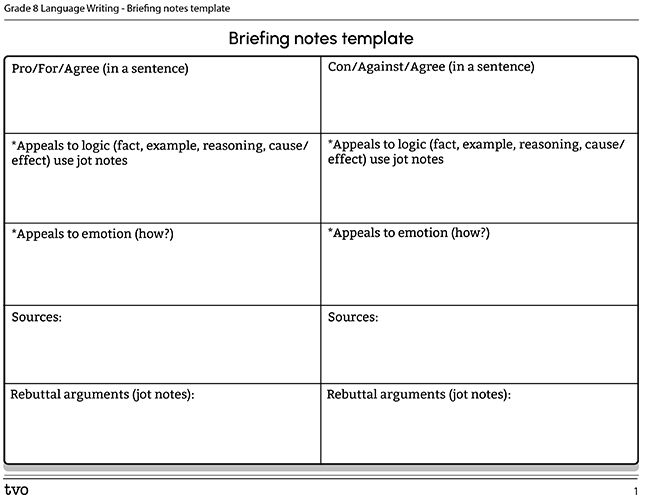Minds On
Agree to disagree?
Think of a time that you and someone you know had a disagreement and you each worked hard to convince the other person who was right. This is called an informal debate. Have you ever examined a formal debate or debate competition? What do you think some similarities and differences between a formal debate and an informal debate might be?
Recall a time when you’ve had an informal debate. What was the topic? How did the topic arise? Who were you debating with? What was their stance (opinion, point of view)? It could have felt more like a discussion where each person was sharing their opinion or point of view. It could have also felt like a heated argument.
Think of a time when you’ve examined or maybe even participated in a formal debate. Think of the debates you may have examined, known of, or participated in with a partner or independently.
- What makes this different than an informal debate?
- What rules might be in place to ensure the debate runs smoothly and professionally?
- How do you think one side wins the debate?
Action
The debate & opposing point of views

A debate has a topic with two opposing sides or points of view as in a battle or fight. A formal debate is a formal argument. All the debaters (either an individual or teams) prepare for the debate by examining both sides:
- the assigned side (the side that will argue) where they organize strong evidence and facts to support their stance or side
- the opposing side (the opposing point of view) to help formulate stronger arguments ahead of time to support the presentation of their assigned side and to best prepare to discredit and/or weaken the opposing side’s arguments, reasoning, and supporting details.
Appeals to logic are supported with facts and/or examples. Using cause and effect, significance, and implications.
Appeals to emotion are done through persuasion with choice of words and presentation of voice, body language, and other elements of speech writing devices (repetition, rhetorical, analogy, metaphor, irony, humour).
Remember, all debaters examine not only their own side but also their opposing side.
Explore this chart of important elements of both sides of a debate
| Pro/For/Agree with Statement | Con/Against/Disagree with Statement |
|---|---|
|
*reasoning (reasons) appeals to logic *supported by facts and examples *also includes appeals to emotion |
*reasoning (reasons) appeals to logic *supported by facts and examples *also includes appeals to emotion |
|
Rebuttal against Opposing Side *strengthen your side *show how your side is more valid, convincing *discredit *show holes in logic of other side *uses cause and effect |
This side listens, takes notes to prepare for rebuttal when it’s their turn. |
|
This side listens, takes notes to prepare for rebuttal when it’s their turn. |
Rebuttal against Opposing Side *strengthen your side *show how your side is more valid, convincing *discredit *show holes in logic of other side *use cause and effect |
You may wish to keep a copy of the important elements for reference.
Press the ‘Activity’ button to access Sides of a Debate Chart.
A formal debate, for which you will be writing briefing notes, requires an examination and evaluation of the side you will be arguing (your stance or side) as well as the opposing side.

Formal debate competitions have a clear structure, format, protocol (procedure with expected behaviours and etiquette/manners), and often work within time limitations for each side to present their arguments (side or stance).
There are opportunities for each side to offer a rebuttal.
The briefing notes you will be writing are to help your side convince or persuade the audience and/or the debate judges to choose your side as the most convincing.
To convince the listeners to agree with your stance, your side will have the chance to give rebuttals or counter the arguments presented by the opposing side.
In order to prepare for a debate, it is important to clearly know the difference between a fact and an opinion.
Debate topics
Examine the following TVO resource.
Consider each side. Are they appealing to logic more than emotion or more towards emotion? How are they presenting their side? How is each side represented? Is it through an expert guest, a citizen, an academic, a person with a personal stake (benefit/gain or inconvenience/loss)? What is the end decision?
Use the Notes Template in your notebook or use the following fillable and printable document to create jot notes for the elements of a debate.
| Topic being debated: | |
|---|---|
|
Two sides of the debate: |
|
|
Appeals to logic for each side |
(Blank)(Blank)(Blank)(Blank) (Blank) (Blank)(Blank)(Blank)(Blank) (Blank) |
|
Appeals to emotion for each side |
(Blank)(Blank)(Blank)(Blank) (Blank) (Blank)(Blank)(Blank)(Blank) (Blank) |
|
Strengths in debating techniques: |
(Blank)(Blank)(Blank)(Blank) (Blank) (Blank)(Blank)(Blank)(Blank) (Blank) |
|
Improvements needed in debating techniques: |
(Blank)(Blank)(Blank)(Blank) (Blank) (Blank)(Blank)(Blank)(Blank) (Blank) |
Examine how the points of view of both sides are presented and represented. Is one side featured more than the other side in the article or video? If so, this is called a bias or favouring one side.

Explore the video again and be the judge for the debate topic.
Use the Jot Notes Template in your notebook or use the following fillable and printable document to create your notes for the debate.
|
Pro/For/Agree (in a sentence) (Blank)(Blank)(Blank)(Blank) (Blank) (Blank)(Blank)(Blank)(Blank) (Blank) (Blank)(Blank)(Blank)(Blank) (Blank) *Appeals to logic (fact, example, reasoning, cause/effect) (Blank)(Blank)(Blank)(Blank) (Blank) (Blank)(Blank)(Blank)(Blank) (Blank) (Blank)(Blank)(Blank)(Blank) (Blank) *Appeals to emotion (how do they do this?) (Blank)(Blank)(Blank)(Blank) (Blank) (Blank)(Blank)(Blank)(Blank) (Blank) (Blank)(Blank)(Blank)(Blank) (Blank) Sources: |
Con/Against/Agree(in a sentence) (Blank)(Blank)(Blank)(Blank) (Blank) (Blank)(Blank)(Blank)(Blank) (Blank) (Blank)(Blank)(Blank)(Blank) (Blank) *Appeals to logic (fact, example, reasoning, cause/effect) (Blank)(Blank)(Blank)(Blank) (Blank) (Blank)(Blank)(Blank)(Blank) (Blank) (Blank)(Blank)(Blank)(Blank) (Blank) *Appeals to emotion (how do they do this?) (Blank)(Blank)(Blank)(Blank) (Blank) (Blank)(Blank)(Blank)(Blank) (Blank) (Blank)(Blank)(Blank)(Blank) (Blank) Sources: |
Brainstorm
Your turn!
The next step is to research the topic by taking jot notes.
Choose one of the following to examine:
- climate change
- the need for recess in schools
- do we have good models for students of this generation?
What would be the two sides of this debate?
Consolidation
Debate notes

In this section, you will need to examine, gather supporting information (facts, examples) for one of the opposing sides of a debate topic with appeals to both logic and emotions, and write briefing notes that could be used in a formal debate.
You will have to think critically (carefully) to judge for yourself when an opinion, not a fact, is shared. If it is an opinion, is it supported by relevant facts, examples, and reasoning?
The following are some potential debate statements.
- Are sporting events like the Olympics important?
- Smartphones during instructional time benefits student learning.
- Plastics, technology, fossil fuels, and anything preventing the preservation of the natural environment and wildlife should be banned and illegal.
Complete the Briefing Notes Template in your notebook or use the following fillable and printable document to create your notes for the debate.
|
Pro/For/Agree (in a sentence) (Blank)(Blank)(Blank)(Blank) (Blank) (Blank)(Blank)(Blank)(Blank) (Blank) (Blank)(Blank)(Blank)(Blank) (Blank) *Appeals to logic (fact, example, reasoning, cause/effect) use jot notes (Blank)(Blank)(Blank)(Blank) (Blank) (Blank)(Blank)(Blank)(Blank) (Blank) (Blank)(Blank)(Blank)(Blank) (Blank) *Appeals to emotion (how?) (Blank)(Blank)(Blank)(Blank) (Blank) (Blank)(Blank)(Blank)(Blank) (Blank) (Blank)(Blank)(Blank)(Blank) (Blank) Sources: |
Con/Against/Agree(in a sentence) (Blank)(Blank)(Blank)(Blank) (Blank) (Blank)(Blank)(Blank)(Blank) (Blank) (Blank)(Blank)(Blank)(Blank) (Blank) *Appeals to logic (fact, example, reasoning, cause/effect) use jot notes (Blank)(Blank)(Blank)(Blank) (Blank) (Blank)(Blank)(Blank)(Blank) (Blank) (Blank)(Blank)(Blank)(Blank) (Blank) *Appeals to emotion (how?) (Blank)(Blank)(Blank)(Blank) (Blank) (Blank)(Blank)(Blank)(Blank) (Blank) (Blank)(Blank)(Blank)(Blank) (Blank) Sources: |
| Rebuttal argument (jot notes) | Rebuttal argument (jot notes) |
Reflection
Take a minute to reflect on your learnings from this lesson:
Identify some strategies you used before you began your writing. Identify some strategies you used during your writing. Identify some strategies you used after writing. Which strategies did you find most helpful? Why? How does being a regular reader help your writing?
Choose two of the following reflection questions about debating:
- How will you judge for yourself if an opinion is valid or not?
- How will you determine if you’ve formed an opinion that is supported by enough details (facts, examples)?
- Do you think reading is important to help you determine if something is a fact or an opinion? Why?
- Why do you think it’s important in reporting the news to give facts from credible sources?
- How do you feel knowing that it’s becoming harder to discern whether information is fake news or falsified?

As you read the following descriptions, select the one that best describes your current understanding of the learning in this activity. Press the corresponding button once you have made your choice.
I feel...
Now, expand on your ideas by recording your thoughts using a voice recorder, speech-to-text, or writing tool.
When you review your notes on this learning activity later, reflect on whether you would select a different description based on your further review of the material in this learning activity.











